The K Ration
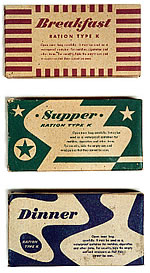 The
Field Ration, Type K was adopted for use in 1942. It was developed
at the request of the U.S. Army Air Force and first used by paratroopers.
As with the C ration, the components of the K rats evolved over
the course of the war to offer greater variety while still maintaining
the need for compact size and balanced nutrition. While the K rats
were designed for only a few days' use under assault conditions,
the demands of war meant that soldiers often ate them for days or
weeks on end, and boredom and complaints naturally ensued. At the
height of the war in 1944, over 105 million of these rations were
produced. The
Field Ration, Type K was adopted for use in 1942. It was developed
at the request of the U.S. Army Air Force and first used by paratroopers.
As with the C ration, the components of the K rats evolved over
the course of the war to offer greater variety while still maintaining
the need for compact size and balanced nutrition. While the K rats
were designed for only a few days' use under assault conditions,
the demands of war meant that soldiers often ate them for days or
weeks on end, and boredom and complaints naturally ensued. At the
height of the war in 1944, over 105 million of these rations were
produced.
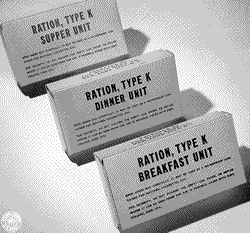 Early
boxes (left) were plain brown card stock. The packaging changed
to a set of distinctive color designs (the "Morale K Ration")
to make it easier for soldiers to quickly select the "right"
meal: brown for breakfast; green for supper; and blue for dinner.
Within these colored boxes the meal was contained in a plain tan
box; this was twice dipped in wax, after the contents were inserted
and the box was sealed, in order to keep the contents waterproof. Early
boxes (left) were plain brown card stock. The packaging changed
to a set of distinctive color designs (the "Morale K Ration")
to make it easier for soldiers to quickly select the "right"
meal: brown for breakfast; green for supper; and blue for dinner.
Within these colored boxes the meal was contained in a plain tan
box; this was twice dipped in wax, after the contents were inserted
and the box was sealed, in order to keep the contents waterproof.
|
Breakfast
Unit
Canned meat product
Biscuits
Compressed cereal bar
Powdered coffee
Fruit bar
Chewing gum
Sugar tablets
Four cigarettes
Water-purification tablets
Can opener
Wooden spoon
|
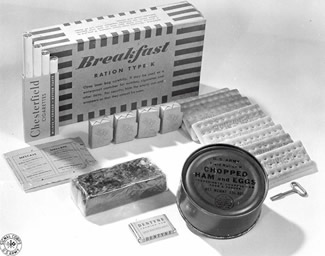 |
|
Dinner
Unit
Canned cheese product
Biscuits
A candy bar
Chewing gum
Powdered beverage
Granulated sugar
Salt tablets
Cigarettes
Matches
Can opener
Wooden spoon
|
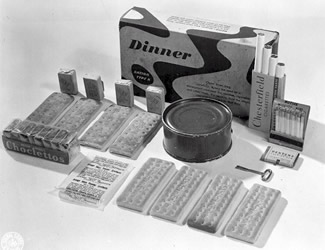 |
|
Supper
Unit
Canned meat product
Biscuits
Bouillon powder
Candy
Chewing gum
Powdered coffee
Granulated sugar
Cigarettes
Can opener
Toilet paper
Wooden spoon
|
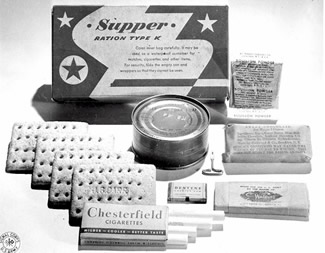 |
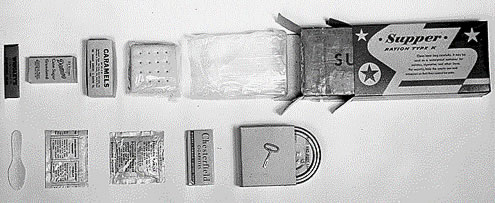
The
canned meat and cheese products were individually boxed in 3"
x 2 3/4" x 1 7/17 cardboard containers, while the other items
were contained in a plastic bag that, according to instructions
on the carton, could be reused for keeping other items such as cigarettes,
matches, letters, and photos waterproof if the bag was carefully
opened.
K Ration Packaging
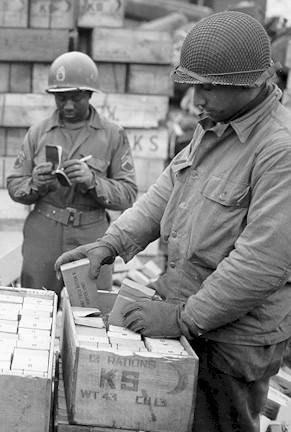 There
were at least two distinct types of wooden K ration containers.
Wooden boxes marked "KS" were early war types (as Hudson
& Allen's product states), and those marked "K" came
later. Gerald Peterson says he has seen both KS and K boxes dated
1944, but the KS crate had the older brown individual meal boxes
in it, while the box marked K had the full color Morale K Ration
boxes in it. There
were at least two distinct types of wooden K ration containers.
Wooden boxes marked "KS" were early war types (as Hudson
& Allen's product states), and those marked "K" came
later. Gerald Peterson says he has seen both KS and K boxes dated
1944, but the KS crate had the older brown individual meal boxes
in it, while the box marked K had the full color Morale K Ration
boxes in it.
According
to C.Q.D. No. 28H, dated August 31, 1945 (superseding an October
31, 1944 directive), twelve K rations were packed on end in a snug-fitting
corrugated fiberboard container. "The arrangement of the cartons
shall be 12 in length (major panels facing), 3 in width, and 1 in
depth. One row of 12 cartons shall be for breakfast, one row for
dinner and one row for supper."
The
fiberboard containers were either placed into wooden boxes directly,
or sealed in a waterproof triple-ply "bag" of kraft paper
or kraft paper, metal foil, and cellophane, before being packed
in the box.
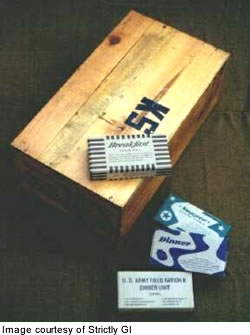 The
C.Q.D. directive does not give the exterior or interior measurements
of the wooden boxes, other than to say the wood was not less than
11/32 inch thick, though the end panels could vary between 3/4 inch
or 5/8 inch thick. However, Gerald Peterson says they were 22 1/4"
x 12 1/4" x 8 1/4". Alan Batens, of Strictly GI, measured
22" x 12 1/4" x 8 1/2", also from a real specimen.
As Alan states, "Mind you, original cases have suffered through
the year, and those diensions could vary a little due to shrinkage
and damage." The
C.Q.D. directive does not give the exterior or interior measurements
of the wooden boxes, other than to say the wood was not less than
11/32 inch thick, though the end panels could vary between 3/4 inch
or 5/8 inch thick. However, Gerald Peterson says they were 22 1/4"
x 12 1/4" x 8 1/4". Alan Batens, of Strictly GI, measured
22" x 12 1/4" x 8 1/2", also from a real specimen.
As Alan states, "Mind you, original cases have suffered through
the year, and those diensions could vary a little due to shrinkage
and damage."
The
directive notes that wooden pieces smaller than the full dimension
of the box panel were assembled with tongue-and-grooved joints.
"Style
4" of the box had wooden cleats "not less than 5/8 x 1
3/4 inches," but does not state where these cleats were placed
on the box; perhaps they are on the underside of the lid, as found
in Tamiya's wooden box below.
The
wooden boxes were then secured with rust-resistant zinc-coated steel
straps, either round (15 or 16 gauge minimum) or flat (3/8"
x 0.015 inches minimum). The "Style 1" box had a strap
wrapped around the ends of the box, and two straps around the top,
bottom, and sides, approximately one-sixth the length of the box
from each end. "Style 4" only had the two straps wrapped
around the top, bottom, and sides.
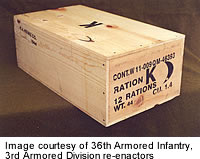 The
directive specifies markings on the wooden box thusly: The
directive specifies markings on the wooden box thusly:
The
upper two-thirds of one end of the nailed wood box shall be printed
in bold Gothic letters as follows:
CONT
______________ (Contract No.) (3/4 inch letters)
RATION K (2 inch letters)
12 RATIONS (3/4 inch letters)
WT 43 (or 41) CU 1.3 (3/4 inch letters)
The
directive also specifies the size of the half moon symbol (3"
tall, 2" wide, and 7/8" thick at the center of the moon.)
Near
the upper right-hand corner of the front side of the shipping
container, the marked end being to the right, the
following information shall be printed...in bold capital letters
between 1/2 and 1 inch high....
___________
(Name of contractor)
___ ___ (Month and year packed; possible packer identifying
code marks)
REQ. ____ (Requisition number; only required on some
containers)
Lengthwise
across the approximate center of both top and bottom of the shipping
container the letter K shall be printed or stenciled in a bold
capital letter approximately 3 inches high.
While
this directive appears after the war ended, it was the best the
Quartermaster Museum could provide and we can assume that any changes
were minimal by that point in the war.
I haven't
been able to determine why most of the packaging we see in historical
photos are the fiberboard containers as opposed to the boxes. It's
likely that the cartons were pulled out of the boxes upon reaching
the major supply depots in order to reduce weight and space for
transit to the front lines. In the Pacific, wooden boxes were used
almost exclusively because the humidity quickly degraded even the
thickest fiberboard.
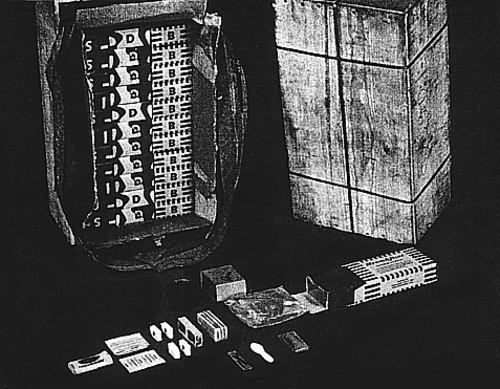
1/35 Scale
K Rations
|
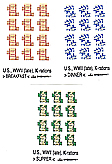 |
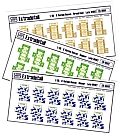 |
|
| Product |
DIOART
- U.S. WWII (late) K-Rations
(129) Breakfast
(130) Dinner
(131) Supper
|
Extra
Detail - K Ration Boxes
(ED-0001)
Breakfast
(ED-0002) Supper
(ED-0003) Dinner
|
Hudson
& Allen Studio (1114)
K-Rations U.S. Army - World War II
|
|
Number
of Items
|
24
individual cardboard meal boxes per set |
12
individual cardboard meal boxes per set. |
6
fiberboard cartons each of early and late styles with sleeves.
|
| Historical
dimensions |
6
15/16 x 3 5/8 x 1 5/8 |
6
15/16 x 3 5/8 x 1 5/8 |
Early:
unknown
Late: 21 1/2 x 12 x 8 (estimated)
|
| Product
dimensions |
8
x 4 x 2 1/2
|
15
x 8 1/2 x 3
|
Early:
21 1/2 x 11 x 9
Sleeve: 21 1/2 x 12 x 9 1/2
Late: 22 x 12 1/2 x 8 1/2
Sleeve: 22 x 13 1/2 x 9
|
| Material
and color |
Bond
paper stock; box colors compare favorably to historical artifacts. |
Heavier
paper stock; green in supper boxes is brighter than historical
artifacts. |
Light
card stock; color is acceptable. |
| Instructions |
No |
No |
Yes |
| Markings |
Designs
appear to be reproductions of actual rations boxes. Meal names
are legible; the rest of the labeling is too small to reproduce
clearly in 1/35 scale. The main label is duplicated on the backside
of the box; I have seen examples that show additional instructions
printed on the backside, rather than a repeat of the meal name
and info as on the front panel. |
Designs
are well produced and meal names are legible; the rest of the
labeling is too small to reproduce clearly in 1/35 scale.
The main label is duplicated on the backside of the box; I have
seen examples that show additional instructions printed on the
backside, rather than a repeat of the meal name and info as
on the front panel. |
Early:
US ARMY FIELD RATION K
42
DINNER UNITS
MACARONI W/CHEESE
WT34, CU1.1, INSP 9-43
fine print and stampings
Late:
FIELD RATION K, KS,
45 IND. SUPPER UNITS
CHICKEN W/DUMPLINGS
WT39
CU1.2 PACKED 4-44
fine print and stampings
|
| Comments |
Slightly
over scale but much better than similar products from Extra
Detail. It's best to score the fold lines before cutting the
boxes from the sheet because they're so small. |
If
not for the problem with these boxes being out of scale, they'd
be quite nice. The paper is nice and firm and holds the box's
shape well. It's best to score the fold lines before cutting
the boxes from the sheet because they're so small. |
Easy
to build and very convincing markings on all sides of sleeve
and 5 sides of cartons.
As
Gerald Peterson notes, it's possible that both versions of
these boxes were used in the field in 1944. You may want to
err on the side of caution and use the early versions in a
North Africa setting, and the later cartons for D-Day and
after.
|
Finished
Product |
Not
available
at
this time
|
|
|
| Final
Thoughts |
These
will be challenging to anyone who is "all thumbs."
But the final product is very good. |
I
passed along information on the size discrepancy to Graham Lawler
at Extra Detail and he promptly pulled these products off the
market so he could redo them properly. |
These
do the best job in coming closest to the real thing. |
|
|
|
|
| Product |
Jadar
Model (3508) U.S. Army K-Rations WWII, 1943 |
Tamiya
(35250) M4A3 Sherman 75mm Gun Late Production and (35251)
M4A3 Sherman with 105mm Howitzer include boxes and decals. |
|
|
Number
of Items
|
12
early sty;e fiberboard cartons (two different meal types)
with sleeves.
|
4
wooden boxes.
|
|
| Historical
dimensions |
Early:
unknown
|
22
1/4 x 12 1/4 x 8 1/4 |
|
| Product
dimensions |
Early:
21 1/2 x 11 x 9
Sleeve: 21 1/2 x 12 x 9 1/2
|
18
x 12 x 7 |
|
| Material
and color |
Tan
card stock; color is acceptable. |
Styrene
and decal; must paint an unfinished wood color. |
|
| Instructions |
Yes,
in Polish, with 4 diagrams. |
Yes |
|
| Markings |
Version
1:
US ARMY FIELD RATION K
42
DINNER UNITS
MACARONI W/CHEESE
WT34, CU1.1, INSP 9-43
fine print and stampings
Version
2:
FIELD RATION K, KS,
45 IND. SUPPER UNITS
CHICKEN W/DUMPLINGS
WT39
CU1.2 PACKED 4-44
fine print and stampings
|
RATION
K
12 RATIONS
WT44 CU1.4
fine print
|
|
| Comments |
Nearly
identical to Hudson & Allen's product in size and markings.
Card stock slightly heavier and textured. |
Boxes
build easily and have "wood grain" on all sides,
but also have ejector marks on interior sides and underside
of top lid. To have an open crate you need to deal with the
marks and remove construction guide tabs. Underside of top
lid has three support cross pieces — these may be the
cleats referred to in "Style 4."
Separate
"K" decal for top lid is nice touch, but no marking
for side panels. Decals are a little thick; Spray the painted
boxes with gloss varnish and use some Solvaset to get them
to snug down tight. Weather slightly and cover with a matte
varnish.
|
|
Finished
Product |
Photo
not available
at
this time.
|
|
|
| Final
Thoughts |
Depending
which area of the world you're modeling in, it may be easier
to purchase this product than the original Hudson & Allen
item. |
Undersized,
and some significant markings are missing on the front and back
sides, but it's the best of the two wooden rations boxes available,
(the other is Tamiya's old 10 in 1 box). |
|
|












